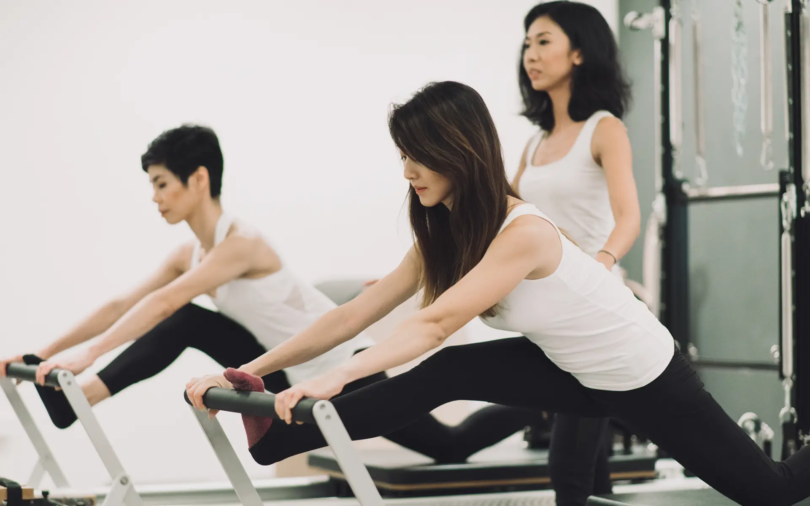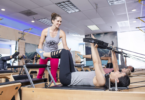Pilates, a widely popular exercise method, has gained recognition for its effectiveness in building core strength, improving flexibility, and correcting posture. Practiced by individuals of all fitness levels, Pilates offers a unique blend of controlled movements, mindful breathing, and proper form to achieve a strong and balanced physique.
Within the world of Pilates, there exist two primary practice formats, namely pilates reformer classes and mat classes. While both formats share the core principles of Pilates, they differ in terms of equipment, intensity, and overall approach.
Core Principles of Pilates: A Foundation for Both Formats
Regardless of whether you choose mat or reformer classes, the core principles of Pilates remain constant. These principles emphasize the importance of developing a strong core, which serves as the center of your body and provides stability for all movements. Pilates also focuses on improving flexibility through a series of stretches and controlled movements that target different muscle groups. Additionally, proper form and alignment are paramount in Pilates, ensuring safe and effective exercise execution. By focusing on these core principles, both mat and reformer classes aim to enhance your overall strength, flexibility, and body awareness.
Mat Pilates: Building a Foundation with Bodyweight Exercises
Mat Pilates classes offer a fundamental introduction to the Pilates method. As the name suggests, these classes involve performing exercises on a mat using your own bodyweight as resistance. While seemingly simple, mat exercises can be surprisingly challenging and effective. Instructors often incorporate props like stability balls, fitness circles, and resistance bands to add variety and increase the difficulty of exercises. The primary benefit of mat Pilates lies in its accessibility. Mat classes generally require minimal equipment, making them a cost-effective option for beginners or those on a budget. Additionally, the portability of a mat allows you to practice Pilates almost anywhere, from your living room to a park. Furthermore, the focus on bodyweight exercises in mat classes allows you to develop a strong foundation in Pilates fundamentals, such as proper breathing techniques, core engagement, and body alignment.
Reformer Pilates: Taking Your Practice to the Next Level
Reformer Pilates classes introduce a specialized piece of equipment: the reformer. This versatile machine features a sliding carriage, adjustable straps, and springs that provide varying levels of resistance and support. The reformer allows for a wider range of exercises compared to mat classes, targeting different muscle groups and offering options for various fitness levels. The springs on the reformer can be adjusted to create resistance, adding intensity and challenge to your workout. Additionally, the reformer can provide support and assistance for specific exercises, making it a valuable tool for those recovering from injuries or individuals with limitations. For instance, the reformer can help stabilize your body during exercises that might be difficult to perform on a mat alone.
Key Differences Between Mat and Reformer Classes: A Breakdown
While both mat and reformer classes share the core principles of Pilates, some key differences set them apart:
- Equipment
The primary difference lies in the equipment used. Mat classes rely solely on your bodyweight and occasional props, while reformer classes utilize a specialized reformer machine.
- Intensity
Reformer classes generally offer the potential for a more intense workout due to the ability to adjust spring resistance. The reformer allows for targeted exercises with added challenge compared to bodyweight exercises on a mat.
- Support and Assistance
The reformer provides unique support and assistance for specific exercises. This can be beneficial for beginners, those recovering from injuries, or individuals with limitations in their range of motion.
- Focus
Mat classes may place a stronger emphasis on core fundamentals and foundational Pilates exercises. Reformer classes, on the other hand, can offer a wider variety of exercises targeting a broader range of muscle groups.
Choosing Between Mat and Reformer Classes: Finding the Right Fit
The choice between mat and reformer classes ultimately depends on your individual needs and fitness goals. Here are some factors to consider:
- Experience Level
If you’re new to Pilates, starting with mat classes is a great way to build a strong foundation in the core principles and proper form. Mat classes are typically less intimidating for beginners and allow you to learn the basics before progressing to the reformer.
- Fitness Goals
If you’re seeking a more challenging workout or want to target specific muscle groups, reformer classes might be a better choice. The reformer’s ability to adjust resistance allows you to tailor your workout intensity to your fitness level.
- Budget
Mat classes are generally more affordable than reformer classes due to the minimal equipment required. This can be a significant factor to consider, especially for those on a budget.
Choose your Class
Whether you choose mat or reformer classes, both formats offer unique benefits and contribute to a well-rounded Pilates practice. Mat classes provide a readily accessible and cost-effective way to build a foundation in core principles and bodyweight exercises. Reformer classes, on the other hand, offer a more dynamic and potentially more intense workout experience with the support of a specialized machine.
Ultimately, the best way to discover which format suits you best is to try both! Many studios offer introductory classes for both mat and reformer, allowing you to experience the differences firsthand and choose the option that aligns best with your preferences and fitness goals. So, why not embark on your Pilates journey today? Check on www.breathepilates.co.th/ to see your options. With dedication and consistency, both mat and reformer classes can help you achieve a stronger, more flexible, and more balanced you.






